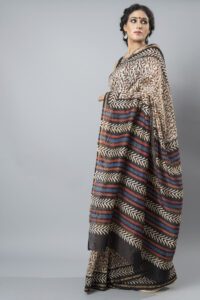No products in the cart.
Let’s take a walk down memory lane – there was a time when textiles were only hand-woven and every design was not a mass-produced print. There was a charm about having a unique, exclusive design that wasn’t splashed across high street fashion. But there is no reason to fret just yet, there is a part of this old world charm that we can still make our own – how, you may ask? The answer is with block prints – these beautiful fabrics bear designs that have a way of paying homage to ethnic styles yet being contemporary.
As you read on, you will be able to acquaint yourself with the process of block printing as well as its various avatars, a style that is in fact largely considered the oldest form of textile printing.
Mid-19th-century dyers hard at work creating fabrics for printingSo, how exactly does block printing work?The origins of block printing can be traced all the way back to ancient civilizations in China and Egypt. Indian block printing adapted the concept to regional tastes and preferences and is now widely popular in the sub-continent. For the purpose of this discussion, we will focus specifically on block printing in India.
Block printing begins with the preparation of the fabric. Cotton is the ideal choice of a base as fabric as a result of its hardiness and ease of working with. The fabric is then soaked in water to make it more pliable to work with. After the fabric is dried and bleached by the sun, the process of making the block commences. For this, the artisan will transfer a carefully created design from paper to a block of wood – mango wood in most cases.
Preparation of a block for printing

Amitesh
Latest Posts
Handloom Conclave – Manthan: A Proud Moment for Aditri at the Heart of India’s Handloom Industry
On January 28th, 2025, New Delhi hosted one of the most significant events in the handloom sector, the
Kota Doria Sarees: A Perfect Blend of Tradition and Comfort
Kota Doria sarees are a symbol of timeless elegance, blending tradition with unparalleled comfort. Originating from the town
Why Ajrakh Sarees Should Be in Your Wardrobe
Ajrakh sarees are more than just garments; they are a celebration of rich heritage, exquisite craftsmanship, and timeless
No results found.






No comment yet, add your voice below!